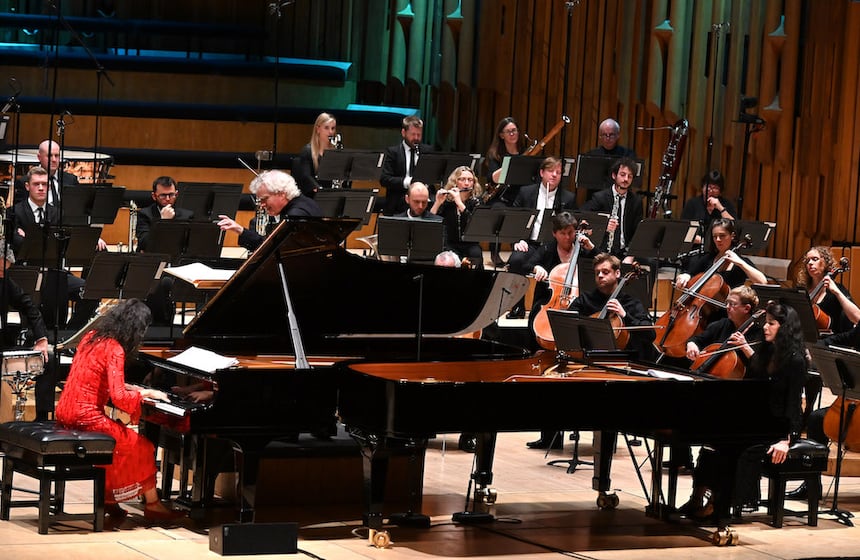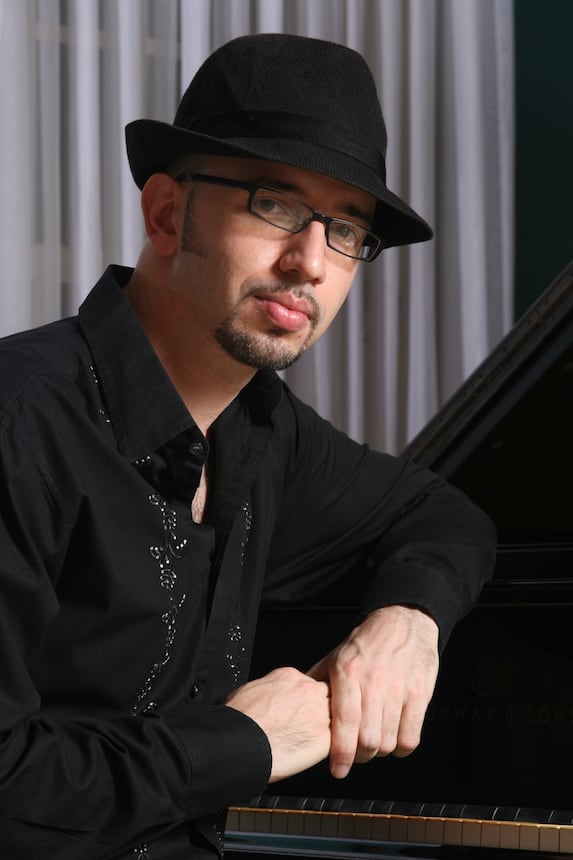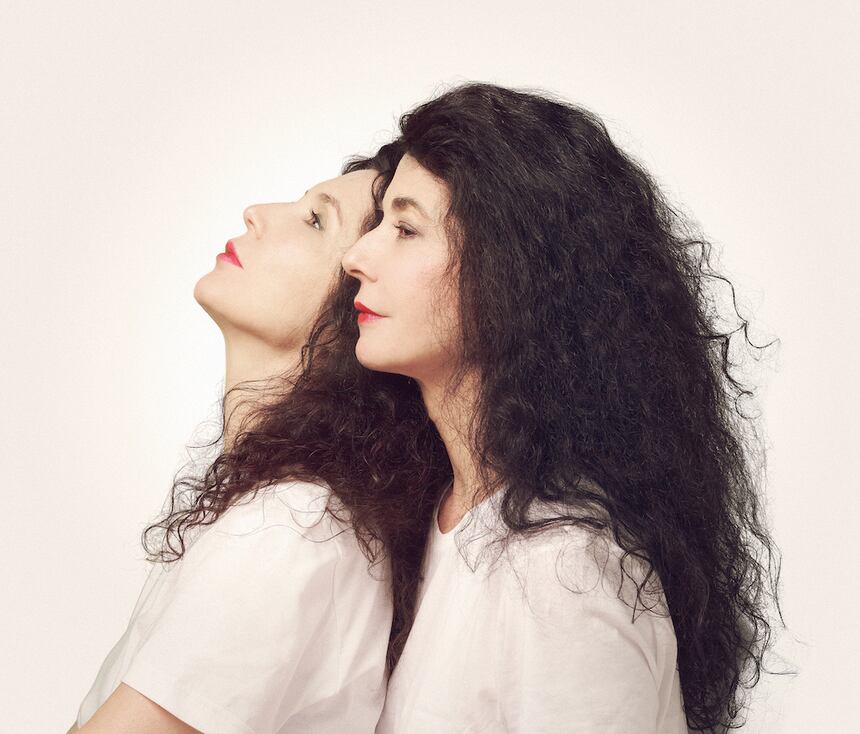With composers such Liszt or Mahler, their “supranationality” or ambiguous cultural identity is often brought up, as well as the influence this has on their music. This is similar to composer Osvaldo Golijov. He was born in Argentina as the son of Eastern European Jewish parents and grew up with Jewish liturgical and Klezmer Music, paired with Argentine tango. When he premiered his Pasión según San Marcos (St. Mark Passion) in 2000 — to commemorate the 250th anniversary of Bach’s death — it quickly became clear that his version of the Christian story was less faithful to its traditional sounds and was retold instead through a Latin American lens. Golijov draws on musical styles from Brazil and Cuba, and also incorporates Afro-Cuban vocals and Brazilian jazz sounds. In 2008, pianists and sisters Katia and Marielle Labèque commissioned Venezuelan multi-instrumentalist and arranger Gonzalo Grau to create a suite of this passion for two pianos and orchestra — and out of this came: Nazareno. More than 10 years were to pass between this idea and the first studio recording, which was all the more perfect for this work. As Grau himself reports: “All new works need time to grow”.
Through the close friendship between the Labèque sister and conductor Sir Simon Rattle, the perfect framework was quickly created to record the piece together with the London Symphony Orchestra (LSO). For this unique project, we had the pleasure of asking composer Osvaldo Golijov and arranger Gonzalo Grau a few questions...
Mr. Golijov, having worked with many classical labels like Nonesuch, Sony Classical or Deutsche Grammophon, can you tell us how the collaboration with the LSO started?
Golijov: I don’t know for sure, I imagine this collaboration stemmed from the friendship and musical kinship between the Labeque sisters and Simon Rattle.
The repertoire of this album perfectly transitions from classical to jazz with Stravinsky and later Bernstein. Does your work Nazareno follow a similar musical tradition to the two composers mentioned?
Golijov: It’s an interesting question. To my mind the relationship Stravinsky had with Jazz was of a completely different nature than the one between Bernstein and jazz. For Stravinsky, again, this is my feeling, jazz was an object, like Latin for his Oedipus Rex, or early music for his Agon. I think for Bernstein it was more of a “lived in” and “believed in” relationship. There is a natural continuum for Bernstein between all the facets of his music making. In my own case, I regret never having studied jazz, even if I love it. If the yes toon applies to the relationship between Latin-American popular music (Brazil and Cuba specifically) and the St Mark Passion, then I’d say that even if I profoundly admire and love Stravinsky, I’m closer to Bernstein in what those languages mean to me. Furthermore, Nazareno is more Gonzalo’s than me. He heard in the St.Mark Passion things I had not heard. And in that sense too, the work is closer to Bernstein than to Stravinsky.

The LSO with Sir Simon Rattle and the Labèque Sisters
How important is it for you to bring your Argentine roots into your music?
Golijov: Sometimes it’s consciously important. Other times I consciously try to steer away from them, quite unsuccessfully if I’m to believe the listeners who always hear them.
Where do you find musical inspiration for your compositions?
Golijov: Everywhere! Sorry for being so general but any human experience, idea, emotion, can be the source of music. So, the inspiration depends on the particular work you’re doing.
Grau: I try to imagine some kind of story behind the music I write. A motif that could be anything. Sometimes, I draw in my mind an imaginary storyline and I develop sounds that accompany that story. But honestly, every piece is different. Some things are more poetic than others, so I can get inspiration from “a cat’s walk”, or from childhood memories.
In 2008, Mr. Grau, you were commissioned by Katia and Marielle Labèque to arrange an orchestrated version of Golijov’s work. Why did the decision to record the work come so much later?
Grau: Summer of 2009 (to be precise), and it was originally orchestrated for “full-orchestra”. I think that Nazareno needed revisions, and it was Sir Simon Rattle who had the great idea of making a smaller orchestration. This new revised “chamber” version was performed by the Berlin Philharmonic, Sydney Symphony Orchestra, Orchestre Philharmonique de Radio France, and many more. I don’t exactly know why it was recorded so much later, but all new works need time to grow, need time to mature and learn all the nuances and tricky spots. Nazareno] is a piece very much based on traditional and folkloric music from South America, and all of these rhythms need to feel loose and natural. It is fascinating to see a piece of music grow over time. I am sure that if we’d decide to record it now “with the same performers”, it would come out differently. So, perhaps that was a reason.

Gonzalo Grau
Can you tell us more about the artistic and musical process of arranging Golijov’s work Nazareno? Was there an artistic exchange with him?
Grau: I am one of the original performers of Golijov’s La Pasión (St. Mark Passion). Since 1998, I’ve had the pleasure to collaborate with Osvaldo in the making of this masterpiece. In it, I play both piano and percussion, I helped orchestrate some of the brass parts and I had been music-producer of the Deutsche Grammophon recording of it. Therefore, I can say I know Golijov’s La Pasión very well, and took the challenge of this arrangement (commissioned by the Labèque’s) for two pianos and orchestra with great excitement. I basically chose the musical sections and movements I thought needed to be there. I remember discussing a bit with Osvaldo the “bigger-structure” of the new piece (still without a name back then). Remember that La Pasión (or mother work), has text, 34 movements and it lasts an hour and thirty minutes, so I definitely had to choose highlights and create a “suite” inspired by La Pasión. This “new piece” needed to have a completely different development, needed its own DNA, being only instrumental, using the most striking motifs from La Pasión but taking these to a different place. I remember showing Osvaldo some first ideas, using the pianos as “percussion” instruments, translating the complex polyrhythms of the “batá drums” to piano vocabulary, and adding harmonies to this. Excited, he encouraged me to continue developing this idea. When the arrangement was ready, we reunited and listened to the entire work (on computer sounds of course) and he suggested a few changes to the slow movement. Again, I think it is marvellous to always be open to suggestions, especially coming from musicians of such calibre. I have made suggested revisions by composer Osvaldo Golijov, conductor extraordinaire Sir Simon Rattle and the amazing Labèque sisters, and this is something I say proudly for sure. Nazareno is definitely a piece that needed this growth.

Katia und Mariella Labèque
Can you give us some insight into working with Sir Simon Rattle, the Labèque sisters and the LSO? How did this shape up?
Grau: As an arranger and composer, working with artists like these is a total “dream come true”. I am a “hybrid musician”. I come from classical music, musician parents, cello studies, early music and choral music, mixed with Latin American folklore, Caribbean, jazz and flamenco. Being able to orchestrate, record and perform a piece like Nazareno gives me a complete “full-circle”, because I feel I connect again with my classical nest, but from my own popular experience. The Labèque sisters share a long artistic history and great friendship with Sir Simon Rattle. They introduced Nazareno to him. He loved the idea of doing it along with Bernstein and Stravinsky. He envisioned this entire program and put together a perfect match for each piece. After we premiered this program in Berlin, two years later he brought the project to London, and voilà!
Are you planning any other similar projects?
Grau: Not at the moment, but I’d love to work with Gonzalo again!
LISTEN NOW TO 'NAZARENO' BY THE LSO, SIR SIMON RATTLE AND THE LABÈQUE SISTERS ON QOBUZ
Visuals © 2022 London Symphony Orchestra

